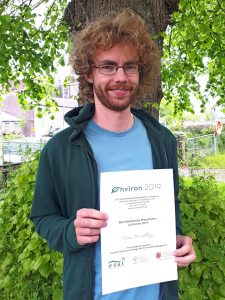Congratulations to Alan McCarthy – Winner of CIEEM sponsored ‘BEST Biodiversity Presentation’ Prize at Environ 2019
NEWS
Congratulations to Alan McCarthy who won the CIEEM sponsored ‘Best Biodiversity Presentation’ Prize at the Environ Conference earlier this year. Alan won 250 euro and free student membership to CIEEM for his  presentation on Predators and prey of Hen Harriers (Circus Cyaneus) in young commercial upland forests. More information on his research can be read here.
presentation on Predators and prey of Hen Harriers (Circus Cyaneus) in young commercial upland forests. More information on his research can be read here.
Predators and prey of Hen Harriers (Circus cyaneus) in young commercial upland forests
Alan McCarthy1, Sandra Irwin1, Anthony Caravaggi1,2, Darío Fernández-Bellon1, John O’Halloran1.
1 School of Biological, Earth and Environmental Sciences, University College Cork.
2 University of South Wales, Glyntaff Upper Campus, 9 Graig Fach, Pontypridd, UK, CF37 4BB.
Corresponding Author Email Address: alanmccarthy@ucc.ie
The uplands of Ireland have undergone significant land use change in recent decades through large-scale afforestation of previously open habitats. For upland specialist bird species, such as the Hen Harrier, this land use change represents a significant threat. While previous research has shown that Hen Harriers have persisted in some areas due to their ability to exploit the earliest stages of the commercial forest cycle for nesting and foraging, this study is the first to assess the suitability of the young forest habitats that are replacing their traditional open habitats. We assessed the prey abundance (small mammals and passerines) and predator communities (mammalian and avian) of young commercial forest habitats. Prey animals recorded in young forests included bank vole, greater white-toothed shrew and several passerine species. Predators recorded included red fox, pine marten, American mink and hooded crow. Our results showed a lower abundance of Hen Harrier prey in young forests compared with open moorland, and a diverse predator community in young forests. These findings demonstrate how afforestation of upland breeding habitats of the Hen Harrier creates areas of lower prey abundance than their traditional breeding habitats, with high predation risk. This has important conservation and management implications, and comes at a time when upland habitats are under more anthropogenic pressures than ever before. These findings will help to inform forest policy and management practices and Hen Harrier conservation strategies throughout Ireland and across their range.
Second rotation pre-thicket commercial forest habitat (foreground), now a widespread habitat in the uplands of Ireland.
Red fox captured with a remote camera trap.
